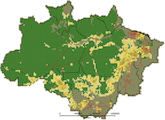geo-ontology
Differences
This shows you the differences between two versions of the page.
| Both sides previous revision Previous revision Next revision | Previous revision Next revision Both sides next revision | ||
|
geo-ontology [2016/05/17 20:55] gilberto |
geo-ontology [2016/05/18 17:05] gilberto |
||
|---|---|---|---|
| Line 8: | Line 8: | ||
| === Outline === | === Outline === | ||
| - | Ontologies of the geographic world are important to allow the sharing of geographic data among different communities of users. A geo-ontology provides a description of geographical entities, which can be conceptualised in two different views of the world. The field view considers spatial data to be a set of continuous distributions. The object view conceives the world as occupied by discrete, identifiable entities. These entities are not merely located in space, they are tied intrinsically to space. To properly capture changes, it is also necessary to describe events and processes. The lectures present a general overview of the main trends in Geospatial Ontology, discussing the concepts of //objects//, //fields// and //events// for representation of geographical phenomena. The course also highlights the specific area of land use and land cover ontology. | + | Ontologies of the geographic world are important to allow the sharing of geographic data among different communities of users. A geo-ontology provides a description of geographical entities, which can be conceptualised in two different views of the world. The //field// view considers spatial data to be a set of continuous distributions. The //object// view conceives the world as occupied by discrete, identifiable entities. Objects and fields are not merely located in space, they are tied intrinsically to space. However, to properly represent changes, it is also necessary to describe concepts that convey the dynamics of spatial phenomena. The notions of events and processes are useful to explicitly include the temporal dimension. The lectures present a general overview of the main trends in Geospatial Ontology, discussing the concepts of //objects//, //fields// and //events// for representation of geographical phenomena. The course also highlights the specific area of land use and land cover ontology, an area of considerable importance for geospatial ontology research. |
| === 1. Describing socially-agreed entities: Geographical Objects === | === 1. Describing socially-agreed entities: Geographical Objects === | ||
| Lecture: [[http://www.dpi.inpe.br/gilberto/cursos/isao2016/lecture-objects-isao2016.pptx|Geographical Objects]] | Lecture: [[http://www.dpi.inpe.br/gilberto/cursos/isao2016/lecture-objects-isao2016.pptx|Geographical Objects]] | ||
| + | |||
| + | [[http://www.dpi.inpe.br/gilberto/cursos/isao2016/reading_objects.pdf|Further Reading and Questions:]] | ||
| * Barry Smith and David Mark, [[http://www.dpi.inpe.br/gilberto/references/SmithMark_SDH1998.pdf| Ontology and geographic kinds]]. Proceedings, International Symposium on Spatial Data Handling, Vancouver, Canada, 1998. | * Barry Smith and David Mark, [[http://www.dpi.inpe.br/gilberto/references/SmithMark_SDH1998.pdf| Ontology and geographic kinds]]. Proceedings, International Symposium on Spatial Data Handling, Vancouver, Canada, 1998. | ||
| * Barry Smith and David Mark, [[http://www.dpi.inpe.br/gilberto/references/smith_mark_geographical_categories.pdf| Geographical categories: an ontological investigation]]. International Journal of Geographical Information Science, 15(7)591-612, 2001. | * Barry Smith and David Mark, [[http://www.dpi.inpe.br/gilberto/references/smith_mark_geographical_categories.pdf| Geographical categories: an ontological investigation]]. International Journal of Geographical Information Science, 15(7)591-612, 2001. | ||
| Line 20: | Line 22: | ||
| * Fred Fonseca, Max Egenhofer, Peggy Agouris, Gilberto Camara, [[http://www.dpi.inpe.br/gilberto/papers/fonseca_tgis_2002.pdf|Ontologies for Integrated GIS]]. Transactions on GIS, 6(3):231-257, 2002. | * Fred Fonseca, Max Egenhofer, Peggy Agouris, Gilberto Camara, [[http://www.dpi.inpe.br/gilberto/papers/fonseca_tgis_2002.pdf|Ontologies for Integrated GIS]]. Transactions on GIS, 6(3):231-257, 2002. | ||
| - | Assignment: [[http://www.dpi.inpe.br/gilberto/cursos/isao2016/assignment_objects.pdf|An essay on “Ontology of Geographical Objects”]] (optional) | + | |
| === 2. Describing the natural world: Geographical fields === | === 2. Describing the natural world: Geographical fields === | ||
| Lecture: [[http://www.dpi.inpe.br/gilberto/cursos/isao2016/lecture-fields-isao2016.pptx|Fields]] | Lecture: [[http://www.dpi.inpe.br/gilberto/cursos/isao2016/lecture-fields-isao2016.pptx|Fields]] | ||
| + | |||
| + | Suggested Reading: | ||
| * Helen Couclelis, [[http://www.dpi.inpe.br/gilberto/references/couclelis_1992_objects_fields.pdf|"People manipulate objects (but cultivate fields): Beyond the raster-vector debate in GIS"]]. In: Frank, A., Campari, I., Formentini, U. (eds.) Theories and Methods of Spatio-Temporal Reasoning in Geographic Space. LNCS, vol. 639. Springer, 1992. | * Helen Couclelis, [[http://www.dpi.inpe.br/gilberto/references/couclelis_1992_objects_fields.pdf|"People manipulate objects (but cultivate fields): Beyond the raster-vector debate in GIS"]]. In: Frank, A., Campari, I., Formentini, U. (eds.) Theories and Methods of Spatio-Temporal Reasoning in Geographic Space. LNCS, vol. 639. Springer, 1992. | ||
| * Gilberto Camara, Max Egenhofer, Karine Ferreira, Pedro Andrade, Gilberto Queiroz, Alber Sanchez, Jim Jones, Lubia Vinhas, [[http://www.dpi.inpe.br/gilberto/papers/camara_fields_giscience2014.pdf|"Fields as a Generic Type for Big Spatial Data"]]. GIScience 2014 Conference. | * Gilberto Camara, Max Egenhofer, Karine Ferreira, Pedro Andrade, Gilberto Queiroz, Alber Sanchez, Jim Jones, Lubia Vinhas, [[http://www.dpi.inpe.br/gilberto/papers/camara_fields_giscience2014.pdf|"Fields as a Generic Type for Big Spatial Data"]]. GIScience 2014 Conference. | ||
| * Karen Kemp, [[http://www.dpi.inpe.br/gilberto/references/kemp_fields.pdf|"Fields as a framework for integrating GIS and environmental process models"]]. Transactions in GIS 1(3):219–234, 1996. | * Karen Kemp, [[http://www.dpi.inpe.br/gilberto/references/kemp_fields.pdf|"Fields as a framework for integrating GIS and environmental process models"]]. Transactions in GIS 1(3):219–234, 1996. | ||
| - | Assignment 2: [[http://www.dpi.inpe.br/gilberto/cursos/isao2016/assignment_fields.pdf|An essay on “Ontology of Geographical Fields”]] (optional) | + | [[http://www.dpi.inpe.br/gilberto/cursos/isao2016/reading_fields.pdf| Questions to Ponder]] |
| === 3. Describing changes in our world: Dynamic spatial ontologies === | === 3. Describing changes in our world: Dynamic spatial ontologies === | ||
| Lecture: [[http://www.dpi.inpe.br/gilberto/cursos/isao2016/lecture-change-isao2016.pptx|Dynamic Spatial Ontologies]] | Lecture: [[http://www.dpi.inpe.br/gilberto/cursos/isao2016/lecture-change-isao2016.pptx|Dynamic Spatial Ontologies]] | ||
| + | |||
| + | Further Reading and Questions to Ponder: [[http://www.dpi.inpe.br/gilberto/cursos/isao2016/reading_change.pdf|“Dynamic Spatial Ontology”]] | ||
| * Andrew Frank, [[http://www.dpi.inpe.br/gilberto/references/frank_spatio_temporal_ontology.pdf| "Ontology for Spatio-temporal Databases"]]. In Spatio-Temporal Databases: The Chorochronos Approach (Lecture Notes in Computer Science 2520), edited by Manoulis Koubarakis and Timos Sellis, 9-78. Berlin: Springer-Verlag, 2003. | * Andrew Frank, [[http://www.dpi.inpe.br/gilberto/references/frank_spatio_temporal_ontology.pdf| "Ontology for Spatio-temporal Databases"]]. In Spatio-Temporal Databases: The Chorochronos Approach (Lecture Notes in Computer Science 2520), edited by Manoulis Koubarakis and Timos Sellis, 9-78. Berlin: Springer-Verlag, 2003. | ||
geo-ontology.txt · Last modified: 2016/08/10 19:32 by gilberto

